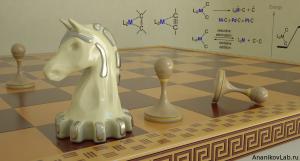 Scientists in Russian Academy of Sciences, Moscow describe a viewpoint on the perspectives of nickel catalysis. Chemical science is in need to replace more and more expansive metal catalysts with easier accessible alternatives. Finding an opportunity to employ non-precious metals would solve the problem and will ensure sustainable future.
Scientists in Russian Academy of Sciences, Moscow describe a viewpoint on the perspectives of nickel catalysis. Chemical science is in need to replace more and more expansive metal catalysts with easier accessible alternatives. Finding an opportunity to employ non-precious metals would solve the problem and will ensure sustainable future.
Catalysis is an outstanding chemical phenomenon that increases the rate of chemical reaction by spending only a tiny amount of additional substance, called a catalyst. The impact of catalysis on our world is remarkable – around 90% of all commercially manufactured products involve chemical substances processed in catalytic procedures at some stage. Whatever we are surrounded by in our everyday life was produced with the help of chemical catalysis – materials, dyes, textile, fuels, paper, devices, cars’ and aircrafts’ parts, …, food, pharmaceuticals, cosmetics and many other.
Due to the fact that only a small amount of catalyst is required to drive a production of chemical substances, the catalytic process can be tuned to high cost-efficiency. For instance, polymerization is an excellent representative example of catalytic efficiency. The manufactured products – polyethylene, plastics, etc. – are produced at million tones scale every year and are consumed in all countries. Another point of catalysis is well reflected by preparation of pharmaceuticals and drugs. Being made at much smaller scale, these unique chemicals require exceptional structural diversity. It is the area, where an outstanding potential of catalysis is now comprehensively explored.
Such increasing growth of industrial production requires more and more catalysts to be developed. The price of metal catalysts has significantly increased and even a tiny amount of catalyst may now cost a lot. For example, the Nasdaq price for widely used catalytic metal – Palladium – was increased by more then 4 times during the last 6 years. Production of catalysts is the main area of consumption of palladium with many demanding applications.
Nowadays the tendency is clearly shifting towards replacing expansive metals by much cheaper analogs. A brief comparison of catalyst prices shows that such a simple metal like Nickel is superior to Pd, Pt, Au, Rh (Figure 1). On the moment these noble metals are ubiquitously used in catalytic applications.
So, is it possible to replace noble metals by nickel in the catalytic applications? The desired goal appears to be rather difficult to achieve. Each metal has a unique set of chemical and physical properties that furnish a particular catalytic transformation. Replacing one catalytic metal for another is in many cases a challenging task.
Of particular interest is the observation of nickel catalyst made about a century ago by the famous chemist and Nobel Laureate Paul Sabatier: “It can be compared to a spirited horse, delicate, difficult to control, and incapable of sustainable work” (P. Sabatier, Catalysis in Organic Chemistry, NY, 1922, p. 15.). Thus, it is not a simple task, but rather a long standing question. Can the chemists force nickel to do a desired synthetic work? Although there are many successful nickel catalysts on the market, the researchers are still facing the challenge.
After multiple unsuccessful direct forcing attempts, chemists have made impressive progress in understanding the mechanisms of nickel-catalyzed reactions. The research provides the opportunity to understand the “spirit” of the metal and to make use of its advantages.







